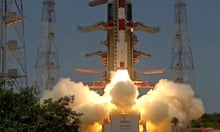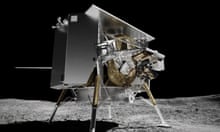Russia’s first moon mission in 47 years has failed after its Luna-25 spacecraft spun out of control and crashed into the moon, dealing a significant setback to the embattled Russian space programme’s attempt to revive its Soviet-era prestige.
The state space corporation Roscosmos said it had lost contact with the craft at 1157 GMT on Saturday after a problem as the craft was shunted into pre-landing orbit. A soft landing had been planned for Monday.
“The apparatus moved into an unpredictable orbit and ceased to exist as a result of a collision with the surface of the moon,” Roscosmos said in a statement. It said a special interdepartmental commission had been formed to investigate the reasons behind the loss of the Luna-25 craft.
Pavel Luzin, an expert on the Russian space programme, said before the mission that Russia needed Luna-25 “to demonstrate that it is capable to do something even without the west”.
The failure underscored the decline of Russia’s space power since the glory days of cold war competition when Moscow was the first to launch a satellite to orbit the Earth – Sputnik 1, in 1957 – and the Soviet cosmonaut Yuri Gagarin became the first man to travel into space in 1961.
The Luna-25 mission sought to land near the south pole of the moon, collecting geological samples from the area, and sending back data for signs of water or its building blocks, which could raise the possibility of a future human colony on the moon.
But the first goal was to prove that Russia still can launch a lunar landing mission after numerous failures in the past, generations of turnover among its scientific experts, delays due to western-imposed sanctions and now isolation because of its war in Ukraine.
Russian state television put news of the loss of Luna-25 at number eight in its lineup at noon and gave it just 26 seconds of coverage, after news about fires on Tenerife and a four-minute item about a professional holiday for Russian pilots and crews.
Russia has been racing against India, whose Chandrayaan-3 spacecraft is scheduled to land on the moon’s south pole this week, and more broadly against China and the US, which both have advanced lunar ambitions.
“India’s Chandrayaan-3 is set to land on the moon on August 23,” the Indian Space Research Organisation (ISRO) posted on X, formerly Twitter, around the time news of the Luna crash broke.
Anatoly Zak, the creator and publisher of the website RussianSpaceWeb, which tracks Russian space programmes, described the flight control system as a “vulnerable area, which had to go through many fixes”.
Zak said Russia had also gone for the much more ambitious moon landing before undertaking a simpler orbital mission – the usual practice for the Soviet Union, the US, China and India.
Russian scientists have repeatedly complained that the space programme has been weakened by poor managers who are keen for unrealistic vanity space projects, corruption and a decline in the rigour of Russia’s post-Soviet scientific education system.
after newsletter promotion
Post-Soviet Russia has launched two failed space landing missions, the Mars-96 in 1996 and Phobos-Grunt in 2011, both of which crash-landed into the Pacific Ocean.
Eventually, in the early 2010s, Russia settled upon the idea of the Luna-25 mission to the south pole of the moon. Luna-25 did manage to exit the Earth’s orbit.
But its failure means Russia may not be the first country to sample the frozen water scientists believe the south pole holds.
It was not immediately clear what long-term impact the failed mission would have on the country’s moon programme, which envisages several more missions over coming years.
“The future of the subsequent launches of Luna-26, Luna-27 and beyond is now in question. Even before the accident, they were promised to be launched no earlier than 2027, and now the deadlines can be shifted more or cancelled altogether,” wrote Vitaly Egorov, a blogger who writes extensively on space exploration.
Reuters contributed to this report










